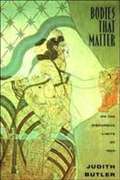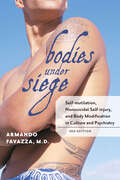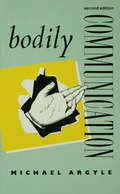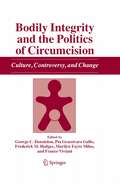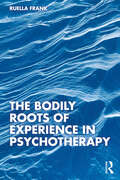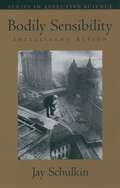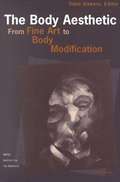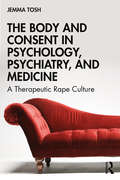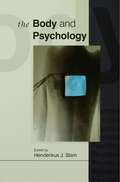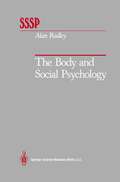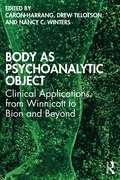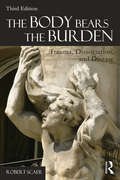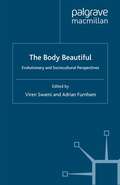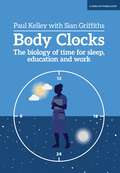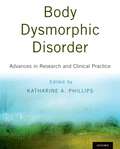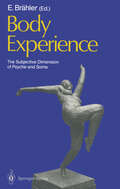- Table View
- List View
Bodies That Matter: On The Discursive Limits Of "sex"
by Judith ButlerIn Bodies That Matter,Judith Butler further develops her distinctive theory of gender by examining the workings of power at the most "material" dimensions of sex and sexuality. Deepening the inquiries she began in GenderTrouble,Butler offers an original reformulation of the materiality of bodies, examining how the power of heterosexual hegemony forms the "matter" of bodies, sex, and gender. Butler argues that power operates to constrain "sex" from the start, delimiting what counts as a viable sex. She offers a clarification of the notion of "performativity" introduced in Gender Troubleand explores the meaning of a citational politics. The text includes readings of Plato, Irigaray, Lacan, and Freud on the formation of materiality and bodily boundaries; "Paris is Burning," Nella Larsen's "Passing," and short stories by Willa Cather; along with a reconsideration of "performativity" and politics in feminist, queer, and radical democratic theory.
Bodies under Siege: Self-mutilation, Nonsuicidal Self-injury, and Body Modification in Culture and Psychiatry
by Armando R. FavazzaA quarter century after it was first published, Bodies under Siege remains the classic, authoritative book on self-mutilation. Now in its third edition, this invaluable work is updated throughout with findings from hundreds of new studies, discussions of new models of self-injury, an assessment of the S.A.F.E. (Self Abuse Finally Ends) program, and the Bill of Rights for People Who Self-harm. Armando Favazza’s pioneering work identified a wide range of forces, many of them cultural and societal, that compel or impel people to mutilate themselves. This new edition examines the explosive growth in the incidence of self-injurious behaviors and body modification practices. Favazza critically assesses new and significant biological, ethnological, social, and psychological findings regarding self-injury; presents current understandings of self-injurious acts from cultural and clinical perspectives; and places self-mutilation in historical and contemporary context.
Bodily Communication
by Michael ArgyleNon-verbal communication - the eye movements, facial expressions, tone of voice, postures and gestures that we all use more or less consciously and more or less effectively - can enhance or diminish every form of social interaction. Michael Argyle's second edition of Bodily Communication is an invaluable up-to-date guide for students of the subject. In the last ten years NVC has become recognized as an important part of social psychology and of professional training, particularly in social work, education and management.Greatly expanded from the first edition, and significantly revised, this second edition has two completely new chapters on social skills and personality, and a new chapter on research methods. The author, a pioneer in the study of non-verbal communication, presents the second edition in the same accessible style as the first, bringing to the reader both his intense interest in the subject and his authoritative knowledge of it.
Bodily Communication
by Michael ArgyleNon-verbal communication - the eye movements, facial expressions, tone of voice, postures and gestures that we all use more or less consciously and more or less effectively - can enhance or diminish every form of social interaction. Michael Argyle's second edition of Bodily Communication is an invaluable up-to-date guide for students of the subject. In the last ten years NVC has become recognized as an important part of social psychology and of professional training, particularly in social work, education and management.Greatly expanded from the first edition, and significantly revised, this second edition has two completely new chapters on social skills and personality, and a new chapter on research methods. The author, a pioneer in the study of non-verbal communication, presents the second edition in the same accessible style as the first, bringing to the reader both his intense interest in the subject and his authoritative knowledge of it.
Bodily Integrity and the Politics of Circumcision: Culture, Controversy, and Change
by George C. Denniston Pia Grassivaro Gallo Frederick M. Hodges Marilyn Fayre Milos Franco VivianiEvery year 13.3 millions boys and 2 million girls are subjected to circumcision, the involuntary removal of part or all of their external sex organs. Bodily Integrity and the Politics of Circumcision illuminates the vulnerability of human society to medical, economic, and historical pressures. It provides a much-needed, thoughtful, and detailed analysis of the devastating impact of circumcision on bodily integrity and human rights, and it provides hope for change.
The Bodily Roots of Experience in Psychotherapy
by Ruella FrankThis book explores the significance of movement processes as they shape one’s experience through life. It provides a comprehensive, practical understanding of how we lose the wonder and curiosity we move with as children, and how we can reclaim that. A new paradigm is presented in the making of experience through a radical and thorough investigation into the basics of animated life. The book utilizes a precise phenomenological language for those subverbal interactions that form the foundation of lived experience. The centrality of those interactions to the therapeutic encounter is set forth through richly detailed therapy vignettes. The building of experience is meticulously explored via the bridging of infant-parent dyads and the functional similarity of those dyads to the unfolding patient-therapist relationship. Readers learn to acknowledge routine inhibitions developed in early life, appreciate their former usefulness, and discover how to restore the lively flow of moving-feeling responses. This book is essential for all psychotherapists who wish to integrate the dynamics of movement into their work; educators who work with babies and young children; and all those wishing to understand better their psychophysical selves.
The Bodily Roots of Experience in Psychotherapy
by Ruella FrankThis book explores the significance of movement processes as they shape one’s experience through life. It provides a comprehensive, practical understanding of how we lose the wonder and curiosity we move with as children, and how we can reclaim that. A new paradigm is presented in the making of experience through a radical and thorough investigation into the basics of animated life. The book utilizes a precise phenomenological language for those subverbal interactions that form the foundation of lived experience. The centrality of those interactions to the therapeutic encounter is set forth through richly detailed therapy vignettes. The building of experience is meticulously explored via the bridging of infant-parent dyads and the functional similarity of those dyads to the unfolding patient-therapist relationship. Readers learn to acknowledge routine inhibitions developed in early life, appreciate their former usefulness, and discover how to restore the lively flow of moving-feeling responses. This book is essential for all psychotherapists who wish to integrate the dynamics of movement into their work; educators who work with babies and young children; and all those wishing to understand better their psychophysical selves.
Bodily Sensibility: Intelligent Action (Series in Affective Science)
by Jay SchulkinAlthough we usually identify our abilities to reason, to adapt to situations, and to solve problems with the mind, recent research has shown that we should not, in fact, detach these abilities from the body. This work provides an integrative framework for understanding how these abilities are affected by visceral reactions. Schulkin presents provocative neuroscientific research demonstrating that thought is not on one side and bodily sensibility on the other; from a biological point of view, they are integrated. Schulkin further argues that this integration has important implications for judgements about art and music, moral sensibilities, attraction and revulsion, and our perpetual inclination to explain ourselves and our surroundings.
The Body Aesthetic: From Fine Art to Body Modification (PDF)
by Tobin Anthony SiebersThe last thirty years of cultural theory have seen a vigorous analytic focus on the human body both as the subject of cultural representations and as an escape from their repressive influence. Rare is the account that focuses on the most obvious fact about the body: it is the stuff out of which human beings are made. Generously and variously illustrated, this volume gathers together the work of literary critics and artists, classicists, art historians, and specialists on the history of the body, who survey the strangeness and variety with which the body has given human beings form. Richard Leppert traces how the representation of little girls responds directly to the cultural anxieties of modernity. Rene Girard plots how starvation becomes an art form, while Eric Gans surveys the contemporary phenomenon of body modification. Sander Gilman explores aesthetic surgery as a response to human unhappiness. Simon Goldhill discovers in the Roman empire the initial stirrings of institutions that focus on the spectacle of the body, and Cynthia S. Greig provides a glimpse of what the history of photography would look like if male nudes replaced female ones. Marion Jackson details how the different physical existence of the Inuit guides the way they make art. Joseph Grigely transforms aesthetics as usual by focusing on the disabled body, while Tobin Siebers describes the traumatic appeal in both fine art and the media of wounded flesh, whether human or animal. The Body Aesthetic is a broad exercise in cultural studies and will address a variety of readers, from those interested in detailed, theoretical accounts of the body, to those interested in belles lettres, to those interested in fine art.
The Body and Consent in Psychology, Psychiatry, and Medicine: A Therapeutic Rape Culture
by Jemma ToshThis groundbreaking text interrogates the constructed boundary between therapy and violence, by examining therapeutic practice and discourse through the lens of a psychologist and a survivor of sexual abuse. It asks, what happens when those we approach for help cause further harm? Can we identify coercive practices and stop sexual abuse in psychology, psychiatry, and medicine? Tosh explores these questions and more to illustrate that many of the therapies considered fundamental to clinical practice are deeply problematic when issues of consent and sexual abuse are considered. The book examines a range of situations where medical power and authority produces a context where the refusals and non-consent of oppressed groups are denied, dismissed, or ignored, arguing that key concepts and discourses have resulted in the production and standardisation of a therapeutic rape culture in the helping professions. Tosh uses critical intersectionality theory and discourse analysis to expertly highlight the complex interrelationships between race, class, gender, sexuality, and disability in our understanding of abuse and how we define survivors. Drawing on a wide range of comprehensive examples, including experiences and perspectives from cisgender and transgender men and women, as well as nonbinary and intersex people, this is essential reading for students and researchers of critical and queer psychology, gender studies, as well as mental health practitioners and social workers.
The Body and Consent in Psychology, Psychiatry, and Medicine: A Therapeutic Rape Culture
by Jemma ToshThis groundbreaking text interrogates the constructed boundary between therapy and violence, by examining therapeutic practice and discourse through the lens of a psychologist and a survivor of sexual abuse. It asks, what happens when those we approach for help cause further harm? Can we identify coercive practices and stop sexual abuse in psychology, psychiatry, and medicine? Tosh explores these questions and more to illustrate that many of the therapies considered fundamental to clinical practice are deeply problematic when issues of consent and sexual abuse are considered. The book examines a range of situations where medical power and authority produces a context where the refusals and non-consent of oppressed groups are denied, dismissed, or ignored, arguing that key concepts and discourses have resulted in the production and standardisation of a therapeutic rape culture in the helping professions. Tosh uses critical intersectionality theory and discourse analysis to expertly highlight the complex interrelationships between race, class, gender, sexuality, and disability in our understanding of abuse and how we define survivors. Drawing on a wide range of comprehensive examples, including experiences and perspectives from cisgender and transgender men and women, as well as nonbinary and intersex people, this is essential reading for students and researchers of critical and queer psychology, gender studies, as well as mental health practitioners and social workers.
Body and Force in Music: Metaphoric Constructions in Music Psychology (SEMPRE Studies in The Psychology of Music)
by Youn KimOur understanding of music is inherently metaphorical, and metaphoricity pervades all sorts of musical discourses, be they theoretical, analytical, philosophical, pedagogical, or even scientific. The notions of "body" and "force" are the two most pervasive and comprehensive scientific metaphors in musical discourse. Throughout various intertwined contexts in history, the body–force pair manifests multiple layers of ideological frameworks and permits the conceptualization of music in a variety of ways. Youn Kim investigates these concepts of body and force in the emerging field of music psychology in the late nineteenth and early twentieth centuries. The field’s discursive space spans diverse contexts, including psychological theories of auditory perception and cognition, pedagogical theories on the performer’s bodily mechanism, speculative and practical theories of musical rhythm, and aesthetical discussion of the power of music. This investigation of body and force aims to illuminate not just the past scene of music psychology but also the notions of music that are being constructed at present.
Body and Force in Music: Metaphoric Constructions in Music Psychology (SEMPRE Studies in The Psychology of Music)
by Youn KimOur understanding of music is inherently metaphorical, and metaphoricity pervades all sorts of musical discourses, be they theoretical, analytical, philosophical, pedagogical, or even scientific. The notions of "body" and "force" are the two most pervasive and comprehensive scientific metaphors in musical discourse. Throughout various intertwined contexts in history, the body–force pair manifests multiple layers of ideological frameworks and permits the conceptualization of music in a variety of ways. Youn Kim investigates these concepts of body and force in the emerging field of music psychology in the late nineteenth and early twentieth centuries. The field’s discursive space spans diverse contexts, including psychological theories of auditory perception and cognition, pedagogical theories on the performer’s bodily mechanism, speculative and practical theories of musical rhythm, and aesthetical discussion of the power of music. This investigation of body and force aims to illuminate not just the past scene of music psychology but also the notions of music that are being constructed at present.
The Body and Psychology (PDF)
by Henderikus J StamThe body has come to provide a central site for theory and debate from social theory to cultural studies. This important and compelling book looks beyond psychology's traditional biological body to explore what insights can be gained from recent theories of embodiment. Taking the body as inscribed by social and disciplinary practices, leading contributors explore a wide range of psychological topics in new and challenging ways. Questions surrounding health, gender, history and culture are addressed in contexts such as the psychology of pain, the treatment of anorexia nervosa, and psychology's relationship to transgender activists. The material in this volume was previously published as a Special Issue of the journal Theory & Psychology.
The Body and Social Psychology (Springer Series in Social Psychology)
by Alan RadleyThis book is about the relationship between social psychology and the body. It starts from the assumption that questions to do with the body are of paramount importance for an understanding of social life. At first sight, this is a noncontentious statement to make, and yet a moment's thought shows that social psychology has had very little to say about this subject to date. Why should this be? Is it because the boundaries of the discipline have been drawn very tightly, focusing exclusively upon such things as attitudes and groups? Is it, perhaps, because the body suggests a field of study best left to biologists and physicians? Or is it because social psychology is well advised to steer clear of problems that draw us back from the social toward what are seen as the biological and the prehistory of our discipline? These were some of the questions that were in my mind when 1 decided to write this book. In addition, I was influenced by the experience of researching in the area of chronic illness. There is nothing quite like life threatening disease to point up mortality and the issues that arise from having to live with the constraints of one's body. Looking for theoretical ideas to help with this work led me to read in the literature of medical sociology.
Body as Psychoanalytic Object: Clinical Applications from Winnicott to Bion and Beyond
by Caron Harrang Drew Tillotson Nancy C. WintersThis book explores the role of bodily phenomena in mental life and in the psychoanalytic encounter, encouraging further dialog within psychoanalysis, philosophy, and the humanities, and contributing new clinical and theoretical perspectives to the recent resurgence of psychoanalytic interest in the body. Presented in six parts in which diverse meanings are explored, Body as Psychoanalytic Object focuses on the clinical psychoanalytic encounter and the body as object of psychoanalytic inquiry, spanning from the prenatal experience to death. The contributors explore key themes including mind–body relations in Winnicott, Bion, and beyond; oneiric body; nascent body in early object relations; body and psychosensory experience; body in breakdown; and body in virtual space. With clinical vignettes throughout, each chapter provides unique insight into how different analysts work with bodily phenomena in the clinical situation and how it is conceived theoretically. Building on the thinking of Winnicott and Bion, as well as contributions from French psychoanalysis, Body as Psychoanalytic Object offers a way forward in a body-based understanding of object relations theory for psychoanalysts and psychotherapists.
Body as Psychoanalytic Object: Clinical Applications from Winnicott to Bion and Beyond
by Caron Harrang Drew Tillotson Nancy C. WintersThis book explores the role of bodily phenomena in mental life and in the psychoanalytic encounter, encouraging further dialog within psychoanalysis, philosophy, and the humanities, and contributing new clinical and theoretical perspectives to the recent resurgence of psychoanalytic interest in the body. Presented in six parts in which diverse meanings are explored, Body as Psychoanalytic Object focuses on the clinical psychoanalytic encounter and the body as object of psychoanalytic inquiry, spanning from the prenatal experience to death. The contributors explore key themes including mind–body relations in Winnicott, Bion, and beyond; oneiric body; nascent body in early object relations; body and psychosensory experience; body in breakdown; and body in virtual space. With clinical vignettes throughout, each chapter provides unique insight into how different analysts work with bodily phenomena in the clinical situation and how it is conceived theoretically. Building on the thinking of Winnicott and Bion, as well as contributions from French psychoanalysis, Body as Psychoanalytic Object offers a way forward in a body-based understanding of object relations theory for psychoanalysts and psychotherapists.
The Body Bears the Burden: Trauma, Dissociation, and Disease
by Robert ScaerWhen The Body Bears the Burden made its debut in 2001, it changed the way people thought about trauma, PTSD, and the treatment of chronic stress disorders. Now in its third edition, this revered text offers a fully updated and revised analysis of the relationship between mind, body, and the processing of trauma. Here, clinicians will find detailed, thorough explorations of some of neurobiology’s fundamental tenets, the connections between mind, brain, and body, and the many and varied ways that symptoms of traumatic stress become visible to those who know to look for them.
The Body Bears the Burden: Trauma, Dissociation, and Disease
by Robert ScaerWhen The Body Bears the Burden made its debut in 2001, it changed the way people thought about trauma, PTSD, and the treatment of chronic stress disorders. Now in its third edition, this revered text offers a fully updated and revised analysis of the relationship between mind, body, and the processing of trauma. Here, clinicians will find detailed, thorough explorations of some of neurobiology’s fundamental tenets, the connections between mind, brain, and body, and the many and varied ways that symptoms of traumatic stress become visible to those who know to look for them.
The Body Beautiful: Evolutionary and Sociocultural Perspectives
by V. Swami A. FurnhamIn this volume, contributors from a range of perspectives - evolutionary psychology to anthropology, sociology to cognitive and motivational psychology - explore questions of what our attractiveness preferences are and why we find certain others physically attractive, offering a fresh perspective to understanding the perception of attractiveness.
Body Clocks: The biology of time for sleep, education and work
by Paul Kelley Sian GriffithsOur body's clocks make the difference between happiness and depression, health and illness, and even life and death. The brilliant scientist Paul Kelley makes a compelling case for all organisations to allow people to work and study the hours that suit their personal circadian rhythms. That way, Paul argues, we would all be more productive, a great deal of ill health would be avoided and the world would be a better and happier place.
Body Dysmorphic Disorder: Advances in Research and Clinical Practice
by Katharine A. PhillipsThis landmark book is the first comprehensive edited volume on body dysmorphic disorder (BDD), a common and severe disorder. People with BDD are preoccupied with distressing or impairing preoccupations with non-existent or slight defects in their physical appearance. People with BDD think that they look ugly -- even monstrous -- although they look normal to others. BDD often derails sufferers' lives and can lead to suicide. BDD has been described around the world since the 1800s but was virtually unknown and unstudied until only several decades ago. Since then, research on BDD has dramatically increased understanding of this often-debilitating condition. Only recently, BDD was considered untreatable, but today, most sufferers can be successfully treated. This is the only book that provides comprehensive, in-depth, up-to-date information on BDD's clinical features, history, classification, epidemiology, morbidity, features in special populations, diagnosis and assessment, etiology and pathophysiology, treatment, and relationship to other disorders. Numerous chapters focus on cosmetic treatment, because it is frequently received but usually ineffective for BDD, which can lead to legal action and even violence toward treating clinicians. The book includes numerous clinical cases, which illustrate BDD's clinical features, its often-profound consequences, and recommended treatment approaches. This volume's contributors are the leading researchers and clinicians in this rapidly expanding field. Editor Katharine A. Phillips, head of the DSM-V committee on BDD, has done pioneering research on many aspects of this disorder, including its treatment. This book will be of interest to all clinicians who provide mental health treatment and to researchers in BDD, anxiety disorders, eating disorders, and other obsessive-compulsive and related disorders. It will be indispensable to surgeons, dermatologists, and other clinicians who provide cosmetic treatment. Students and trainees with an interest in psychology and mental health will also be interested in this book. This book fills a major gap in the literature by providing clinicians and researchers with cutting-edge, indispensable information on all aspects of BDD and its treatment.
Body Dysmorphic Disorder: A Treatment Manual
by David Veale Fugen NezirogluThis book is a unique treatment manual which looks at the assessment of BDD, offering an treatment model in the form of CBT and pharmacotherapy Summarises the current knowledge and theoretical perspectives about BDD Covers the practical aspects of assessment, engagement, and therapy Uses a number of practical resources, including client handouts
Body Dysmorphic Disorder: Advances in Research and Clinical Practice
This landmark book is the first comprehensive edited volume on body dysmorphic disorder (BDD), a common and severe disorder. People with BDD are preoccupied with distressing or impairing preoccupations with non-existent or slight defects in their physical appearance. People with BDD think that they look ugly -- even monstrous -- although they look normal to others. BDD often derails sufferers' lives and can lead to suicide. BDD has been described around the world since the 1800s but was virtually unknown and unstudied until only several decades ago. Since then, research on BDD has dramatically increased understanding of this often-debilitating condition. Only recently, BDD was considered untreatable, but today, most sufferers can be successfully treated. This is the only book that provides comprehensive, in-depth, up-to-date information on BDD's clinical features, history, classification, epidemiology, morbidity, features in special populations, diagnosis and assessment, etiology and pathophysiology, treatment, and relationship to other disorders. Numerous chapters focus on cosmetic treatment, because it is frequently received but usually ineffective for BDD, which can lead to legal action and even violence toward treating clinicians. The book includes numerous clinical cases, which illustrate BDD's clinical features, its often-profound consequences, and recommended treatment approaches. This volume's contributors are the leading researchers and clinicians in this rapidly expanding field. Editor Katharine A. Phillips, head of the DSM-V committee on BDD, has done pioneering research on many aspects of this disorder, including its treatment. This book will be of interest to all clinicians who provide mental health treatment and to researchers in BDD, anxiety disorders, eating disorders, and other obsessive-compulsive and related disorders. It will be indispensable to surgeons, dermatologists, and other clinicians who provide cosmetic treatment. Students and trainees with an interest in psychology and mental health will also be interested in this book. This book fills a major gap in the literature by providing clinicians and researchers with cutting-edge, indispensable information on all aspects of BDD and its treatment.
Body Experience: The Subjective Dimension of Psyche and Soma Contributions to Psychosomatic Medicine
by H. Appelt H. Becker P. Bernhard D. Bongers Elmar Brähler W. Dahlmann H. C. Deter P. Diederichs R. Ernst H. Felder U. Gieler W. Hettich C. Heintze-Hook M. Jarka P. Joraschky M. Lohs P. Möhring H. Müller-Braunschweig A. Otten B. Strauß P. M. WiedemannIn this book body experience is seen as the subjective expression of psyche and soma and is discussed in relation to its significance in modern medical practice and psychoanalysis. The authors relate how the patient's subjective expression of his or her body frequently plays only a marginal role in current therapy and how the central factor of many diseases is consequently missed. Particularly in the growing field of psychoanalytic psychosomatic medicine it will be necessary to pay the issue of body experience more attention. These theoretical and empirical contributions on body experience were specially prepared for the volume. Initial chapters cover a variety of aspects of body experience and its general significance in medicine and psychoanalysis. Following chapters consider body-oriented forms of therapy, sex-related aspects of body experience and the empirical measurement of body experience and bodily complaints.
